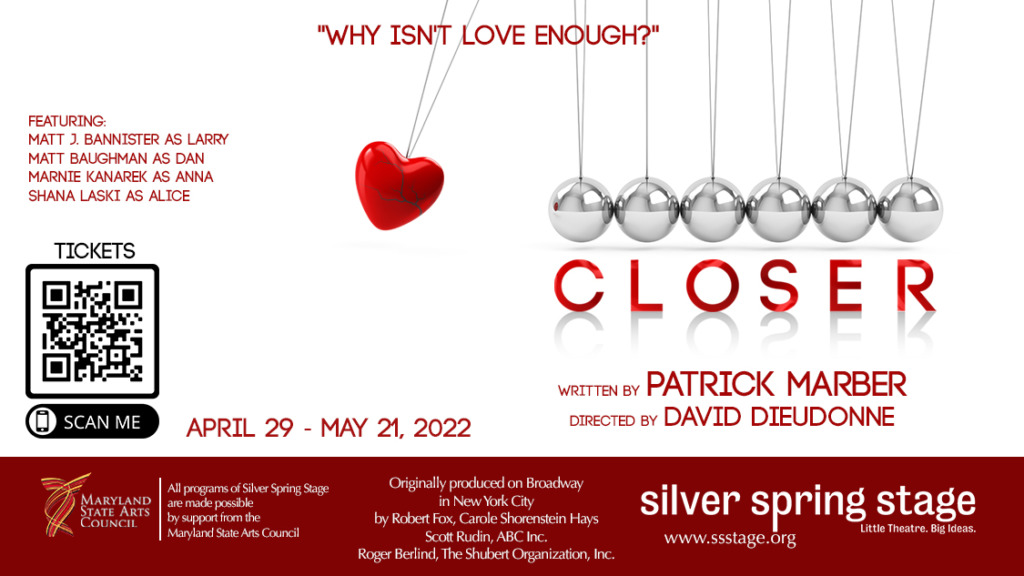Everything’s a version of something else. Try lying for a change, it’s the currency of the world. With taglines like those, one hardly expects the intimate and fascinating dissection of human relationships that one gets with Patrick Marber’s Closer. Appearing now as a co-production between Cogent Theater Collective and Silver Spring Stage, Closer (a play published in 1997 and later transformed into a silver-screen feature of the same name) is produced by Diego Maramba and directed by David Dieudonne. There is something deeply unsettling and yet wildly striking about this production that keeps your mind in a heightened state of interested fervor straight through to the show’s conclusion.
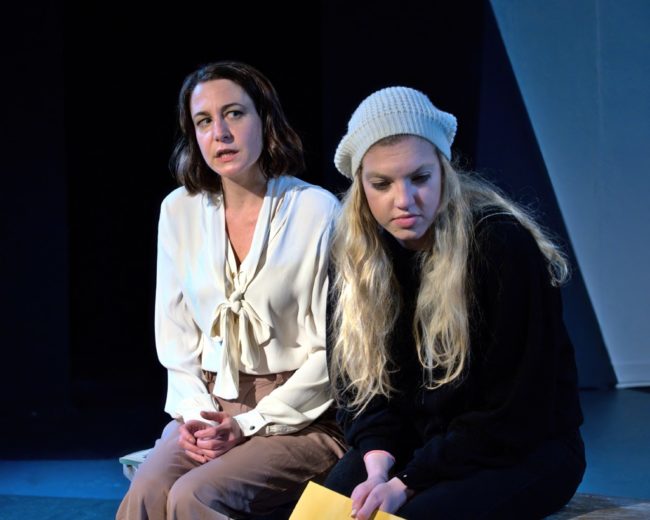
It takes an incredibly seasoned directorial hand and a deep bench of talented actors to take a work like Patrick Marber’s Closer and have the audience engrossed in every scene as it unfolds. The characters are not particularly likeable; they are certainly not redeemable, and of the four that there are, there’s only one who might have a shot at garnering true empathy. While these four characters— Alice, Anna, Dan, and Larry— are perhaps a peg above the loathsome miscreants featured on HBO’s Succession, it does seem that their deep inner lives are distorted and dark enough that the average audience could easily lose interest in their inveiglements after just a few scenes. This, however, is not the case under David Dieudonne’s superbly skilled direction. This production becomes a masterclass in how to take the lives of four characters who are undeserving of attention, interest, empathy, and sympathy and draw the audience into their existence in rapt attention.
Dieudonne works the show with a meticulous meter marking out the production’s pacing. Each scene has a flow to it that wends and meanders through some turbulent emotional trauma. The pacing of the scenes are extremely well-done. (The second act’s scenic changes, which are covered in subdued semi-darkness and the machinations of sound designer Matthew Datcher, are sluggish and do add a bit of a lapse in the show’s overall progressive pacing, but with the run of the show these could be expected to tighten and the gaps will hopefully become less noticeable.) Working with Intimacy & Fight Choreographer Mallory Shear, Dieudonne exacts some of the most striking and stunning performances out of these four individuals as they couple up and switch around and fight with one another throughout the production. Shear’s work is stellar; one of the most intimate scenes where you feel so unsettled watching such a personal and intimate moment between the Larry and Alice character doesn’t involve any physical touching whatsoever, and yet with Shear’s guidance, Dieudonne is able to block and construct this scene that feels even more taboo and deeply intimate than if you were watching the two performers simulate a sex scene. Shear’s finesse on crafting these intimate moments all throughout the play is a palpable force, and serving as an invisible fifth character in the work.
Craftily utilizing the exquisite work of Sound Designer Matthew Datcher, Dieudonne has taken these scenes, which are intrinsically little, microscopic slivers of human intimacy, ever-turning in this nauseating carousel of the human carnival and set them to a haunting calliope of a score which readily reflects all of the lust, deceit, betrayal, and sorrow that fills these characters’ lives. Datcher’s work with the musical scoring, featured between scenes, keeps you purposefully off-kilter, readily unbalanced just like the emotional upheaval happening on the stage. You’re never quite sure if the inter-scene music is ominous or beautiful, romantic or sad, or maybe all of the above and none of the above all at once. Datcher keeps you perpetually unsettled with the sounds he’s selected in the same sense that the play is perpetually unsettling as it delves deeper and deeper into the relationships of the characters. Datcher also provides authentic background noises for scenes in the restaurant, café, art showing, and hospital A&E.
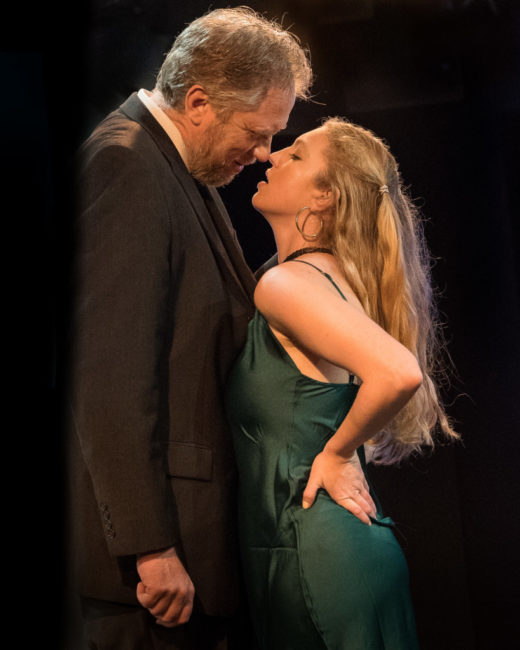
Datcher’s sound design falls in line with Projection Designer Michelle Bowen-Ziecheck, whose work is the imagination’s primer for Set Designer Jeffery Asjes. Bowen-Ziecheck and Asjes work in tandem to transform the uniquely situated staging space of the Silver Spring Stage underground into a plethora of places, all of which involve minimal furnishings— a bench, or table and chairs and sometimes nothing at all— informed by the pre-scene and in-scene projections. Think of Bowen-Ziecheck and Asjes like the coloring book architects of Closer’s scenery where Asjes creates the outlines and Bowen-Ziecheck fills in the colors. Their work, along with the simplistic yet effective work of Lighting Designer Don Slater, gives the show just enough dressing to let the performances stand on their own whilst still contextualizing location. (A boatload of praise goes out to Bowen-Ziecheck and again Sound Designer Matthew Datcher for their combined efforts in flawlessly recreating the “internet-bait-chat” scene, which features the two male actors on stage and a whole bunch of brilliant, albeit extremely lewdly mature, projections of ‘IM-exchanges’ appearing on the projection screens, complimented by the old-school authentic sounds of the days of instant-internet messaging.)
And while there aren’t many places to praise Costumer Lizzie Bartlett Holman’s work— not for lack of effort or interest on her part, the script simply doesn’t lend itself to lavish, excessive costuming necessity— the rather striking emerald dress seen on the Alice character at the art gallery opening lands it mark as does the apricot cream teddy featured in later scene for that same character. The negligee is both risqué and tasteful; the work of the aforementioned intimacy coordinator and the actress’ overall confidence in the way she moves around the stage in this scene makes this one of the most intense moments in the performance.
If there’s one complaint to be had about the show it’s that at times, and most often with the actress playing Alice, the projection volume of the conversations becomes too intimate and difficult to hear. Even though the space is generous with its overall acoustics, there are times when even though the conversation is supposed to appear small and private, softly exchanged words between two characters— the audience still needs to be able to hear these exchanges and they just don’t because the words are being whispered rather than projected in a way that suggests whispering.
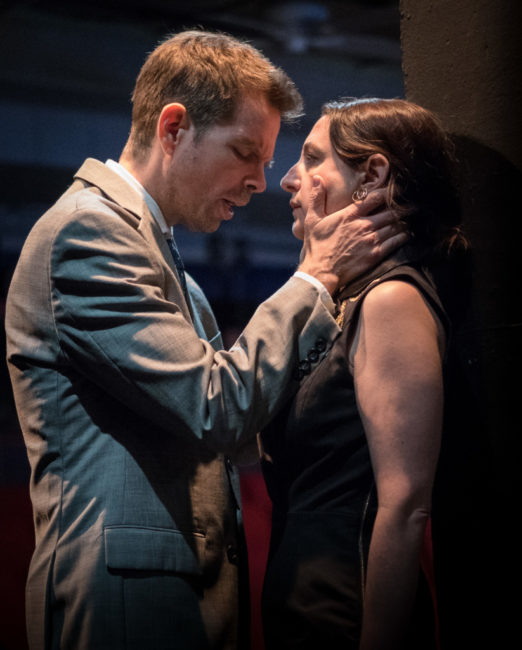
Shana Laski, Matt Baughman, Matt J. Bannister, Marnie Kanarek— four performers (under the exquisite direction of David Dieudonne, intimacy-coordination of Mallory Shear, and dialect coaching of Pauline Griller-Mitchell) bring four very unusual characters to life, weaving their lives together in a complicated web of lies, lust, deception, and intimacy in ways that are truly unimaginable and must be seen to be believed. Closer is a show that is difficult to describe without meticulously detailing each of the plot points that draws these four individuals together and the dynamic interplay between their relationships that results from those moments where love and lust and lies collide. While there’s never any one moment where all four individuals share the stage in a collaborative scene, you feel as if they are all hovering just on the periphery of each other’s moments and in each other’s scenes, so well-established are their existences in each other’s lives that you can feel them— often times hanging like a weighted noose— hanging around the proverbial necks of the others who are physically in the scene as it unfolds.
The character who might come closest to garnering the audiences’ sympathies and empathies might be Dan (Matt Baughman.) One of Baughman’s early scenes— opposite Anna— is loaded with tension, as are so many of these scenes. Baughman is pouring his heart out, quietly, desperately, pleadingly to the Anna character and all of the restraint of suppressing requited sensations are reflecting back hard in his face, giving him a pitiable quality like no other. There is an almost imperceptible vulnerability to Baughman’s approach to the character. All of the character’s have their weaknesses and some show them in more forward ways than others, but Baughman presents a direct throughline to his character’s vulnerability, often expressed in his eyes and very open body language. It’s an impressive feat. And despite the events in the final scene between Baughman and the Alice character, which is a different type of raw exposure, one still finds the ability to feel compassion for his character and largely applaud his performance. And his accent is the most consistent in the production.
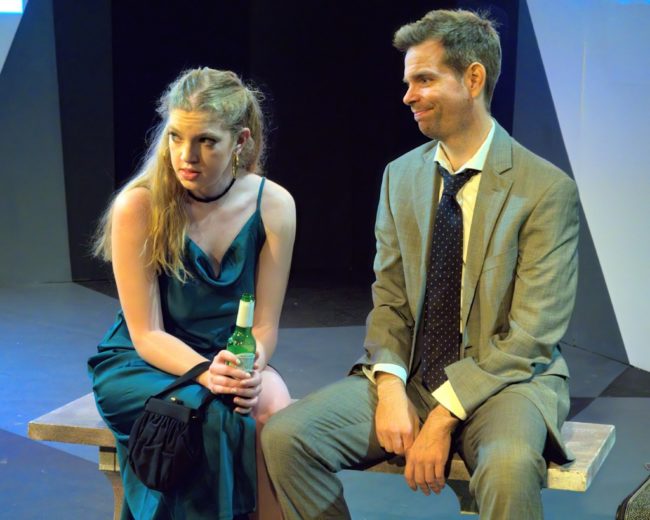
Playing the hardened and enigmatic Alice, Shana Laski is one of the more fiery elements of this performance quartet. As the only American character, Laski presents a perpetually jaded and aloof frontage to the character of Alice, which is a marvelous mask to the deeply disturbed inner life of Alice. The production itself is peppered with these moments of raw beauty— both emotional and physical— and one such moment comes with Laski is posing for the Anna character; its just a simple photograph but there is such a raw exposure of expression between the pair in that moment, largely brought on by Laski’s facial expressions that it’s really a breathtaking moment.
Laski plays opposite Larry (Matt J. Bannister) a fair bit in this performance (though truthfully all four take turns rotating through interactions with one another) and one of the most harrowing scenes is the ‘club’ scene where Laski masterfully parades her character through a series of intense questions and demands. Bannister, whose imposing height makes his character even more intimidating in that moment, goes on a visceral verbal attack that guts both audience and scene partner, leaving everyone in shock. Bannister’s portrayal of Larry is a beautiful disaster, blending self-assured masculinity with a strange insecurity— a desperate need to be grounded in some sort of reality even if he doesn’t accept or understand that reality. It makes for a perplexing and fascinating performance, particularly when playing scenes opposite the curious mix of self-destructive pleasurable indulgence that Laski brings to the table.
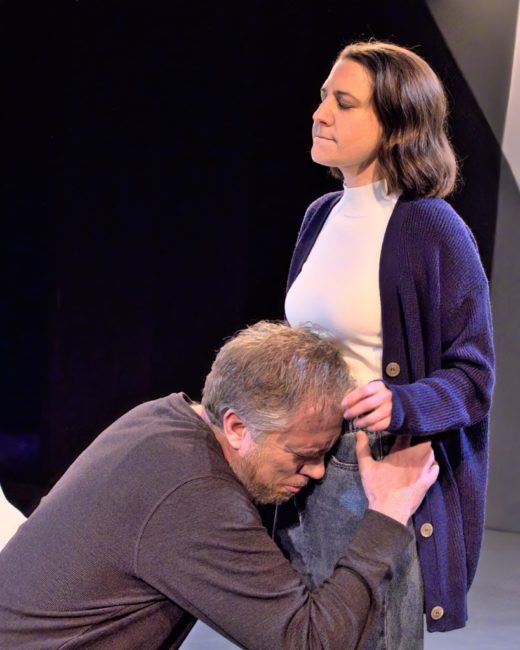
Anna (Marnie Kanarek) is a force to be reckoned all her own. If Laski’s Alice is fiery than Kanarek’s Anna is a tsunami of water that splashes over everything but remains hidden until that last exacting moment of impact. There is a consistent and almost frenetic throughline of tension that courses throughout the play, shifting and morphing with each relationship dynamic, but often when Kanarek enters a scene, the gravity of emotional tension pulls directly to her, as if she is some sort of universal center for feelings. There is a full-on explosion from Kanarek’s Anna in the second act that unleashes the full fury of her character’s emotional baggage and it is nothing short of emotionally brilliant. Kanarek’s character is the least fully explored in Marber’s setup but the most openly available from an emotional standpoint despite all of the scenes where she’s forced to keep her emotions fully reserved and in check.
Aren’t we all just a bunch of tiny little lies perceived by others as absolute truths? Don’t we all need to look just a little bit closer at our relationships to see what they really are, or who they really are with? It’s a fascinating brutal delve into the reality of human inveiglement which David Dieudonne and his cast undertakes brilliantly, presenting a magnificent theatrical triumph. Get your tickets to Closer before time runs out.
Running Time: Approximately 2 hours and 40 minutes with one intermission
Closer plays through May 21, 2022 as a co-production between Cogent Theater Collective and Silver Spring Stage. Performances are held at Silver Spring Stage— 10145 Colesville Road in Silver Spring, MD. For tickets call the box office at 301-593-6036 or purchase them online.

